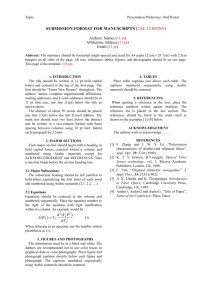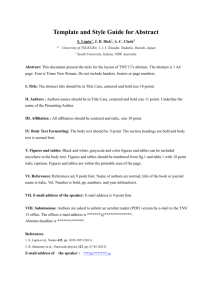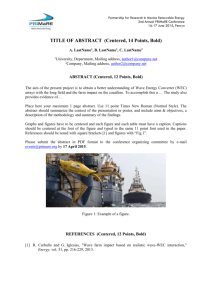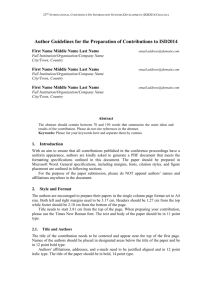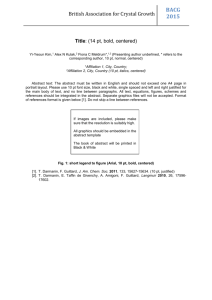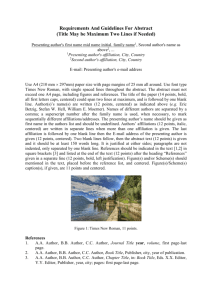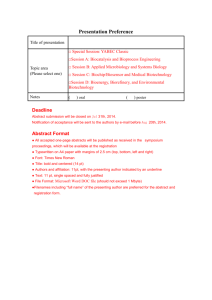Download..
advertisement
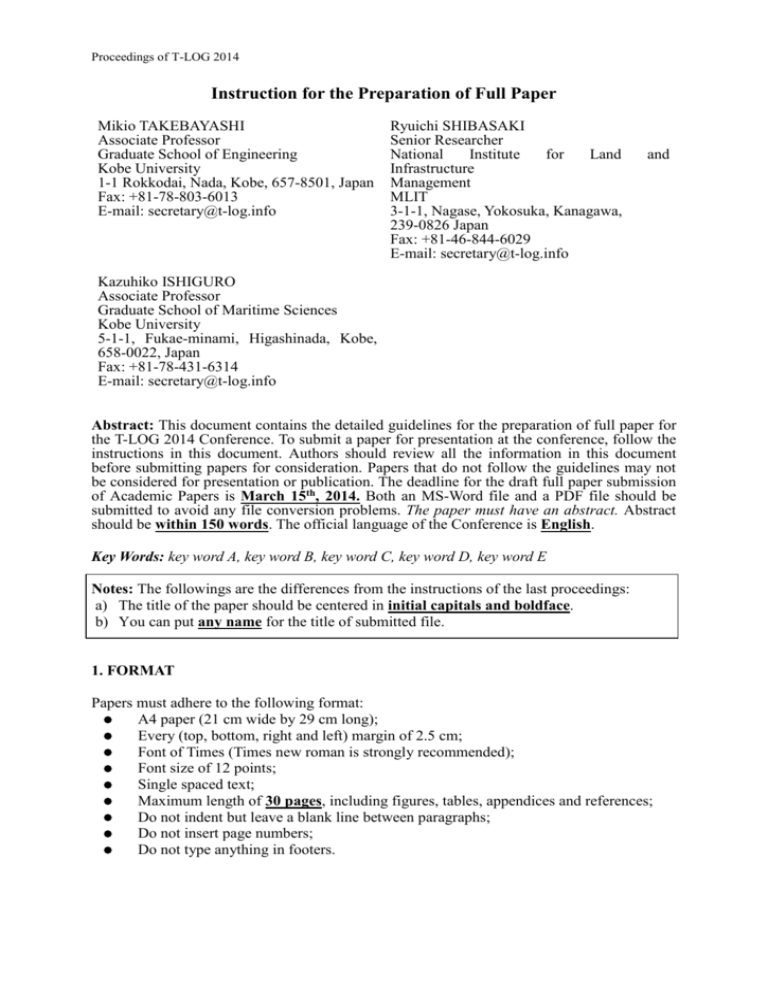
Proceedings of T-LOG 2014 Instruction for the Preparation of Full Paper Mikio TAKEBAYASHI Associate Professor Graduate School of Engineering Kobe University 1-1 Rokkodai, Nada, Kobe, 657-8501, Japan Fax: +81-78-803-6013 E-mail: secretary@t-log.info Ryuichi SHIBASAKI Senior Researcher National Institute for Land Infrastructure Management MLIT 3-1-1, Nagase, Yokosuka, Kanagawa, 239-0826 Japan Fax: +81-46-844-6029 E-mail: secretary@t-log.info and Kazuhiko ISHIGURO Associate Professor Graduate School of Maritime Sciences Kobe University 5-1-1, Fukae-minami, Higashinada, Kobe, 658-0022, Japan Fax: +81-78-431-6314 E-mail: secretary@t-log.info Abstract: This document contains the detailed guidelines for the preparation of full paper for the T-LOG 2014 Conference. To submit a paper for presentation at the conference, follow the instructions in this document. Authors should review all the information in this document before submitting papers for consideration. Papers that do not follow the guidelines may not be considered for presentation or publication. The deadline for the draft full paper submission of Academic Papers is March 15th, 2014. Both an MS-Word file and a PDF file should be submitted to avoid any file conversion problems. The paper must have an abstract. Abstract should be within 150 words. The official language of the Conference is English. Key Words: key word A, key word B, key word C, key word D, key word E Notes: The followings are the differences from the instructions of the last proceedings: a) The title of the paper should be centered in initial capitals and boldface. b) You can put any name for the title of submitted file. 1. FORMAT Papers must adhere to the following format: A4 paper (21 cm wide by 29 cm long); Every (top, bottom, right and left) margin of 2.5 cm; Font of Times (Times new roman is strongly recommended); Font size of 12 points; Single spaced text; Maximum length of 30 pages, including figures, tables, appendices and references; Do not indent but leave a blank line between paragraphs; Do not insert page numbers; Do not type anything in footers. 2. STRUCTURE The cover page of this document is an example of the first page of a full paper. The title of the paper should be centered in initial capitals and boldface. Each author’s name, title, organization, its address, facsimile number and e-mail address must be included. Each author’s surname should be typed in capitals. If there is only one author, a box of the author’s information should be centered whereas the author’s name, title, organization, etc. should be left aligned in the box. If there are two authors, the second author’s information should be placed on the right side of the first author’s one. If three, the third author’s information should be placed under the first author’s as described in this document. An abstract must be within 150 words, and three to five key words should be provided. Then, after two blank lines, the main body of the paper starts. The main body is divided in chapters, (optionally) sections, and (optionally) subsections. Chapters must be numbered and their title typed in bold capitals (for example, 1. INTRODUCTION). Sections must be numbered using two digits and their title typed in bold typeface (for example, 2.1 Data Collection). Subsections must be numbered using three digits (for example, 3.1.2 Model Validation). Two blank lines must be left before each chapter title with the exception of new pages and one blank line must be placed after each chapter title. One blank line must be left before each section/subsection title with the exception of new pages and no blank line should be placed after each section/subsection title. All the text must start at the left margin (that is, new paragraphs are not to be indented) with the exception of listings, which may be indented. The order of the paper is as follows: First: Title, authors’ information, and the chapters of the main text, which are numbered as indicated above. Second: The ACKNOWLEDGEMENTS (title is centered and in bold capital typeface) if required. Third: The REFERENCES (title is centered and in bold capital typeface) Fourth: Appendices if required. 3. SUBMITTED FILES Authors are requested to submit a draft full paper as a PDF file as well as an MS-WORD file. The submitted PDF file needs to be viewed and printed by “Adobe Acrobat Reader 7.0” or “Adobe Acrobat Reader 8.0”. The requirements of submitted PDF files are “Embedding all fonts” and “Bitmapped image over 300 dpi resolution”. You can put any name for the title of submitted files. Do not set a password to the submitted PDF file. If a password is set to the PDF file, it is impossible for the ISC Secretariat to edit the file for the CD-ROM. Never use multi-byte characters. The ISC Secretariat strongly recommends using "Times new roman", "Helvetica" and "Symbol" as font sets. It is recommended that equations should be changed to JPEG pictures, etc. to prevent character code errors. The ISC will not answer to authors for any problem caused by file errors or character code errors. We recommend that authors check the file on different computers. 4. EQUATIONS, TABLES AND FIGURES Equations must be written preferably with the same word processor used for the rest of the text, without hand-written symbols in order to be legible. Equations must be numbered sequentially with their numbers in parenthesis and right justified. U a t a , ca i U c , d Uita tia q i p a a ic i (1) Tables must be numbered sequentially and have a reasonably explanatory title centered over the table. Table 1 Estimation results of the models Model 1 Model 2 Model 3 Variables Parameters T-statistics Parameters T-statistics Parameters T-statistics Travel time -0.0124 -5.43 -0.0222 -5.99 -0.0113 -2.99 Travel cost -0.00451 -8.55 -0.00322 -4.33 -0.00201 -9.31 Service frequency -0.155 -4.88 -0.147 -3.98 -0.221 -1.99 Initial log-likelihood -1432.11 -1432.11 -1432.11 Final log-likelihood -1043.68 -1114.66 -1108.19 Number of observation 2489 2489 2489 Figures must be drawn using good quality graphic software; they must be numbered sequentially and have a reasonably informative title centered under the figure. Auto Rail Bus Air Figure 1 Choice tree of inter-regional transport modal choice 5. REFERENCES The Harvard System of reference must be used. In the body of the text papers or documents are referred to by the author’s surname with the year of publication in parenthesis such as "Greene (1993)"; if the quotation is itself in parenthesis, the year of publication is separated by a comma such as (Dewan and Smith, 2003; Kockelman, 1998). If the reference has more than two authors, only the surname of the first author followed by et al. in italics will appear in the body of the text, for example Auerbach et al. (1994). To complete the paper, references must be given alphabetically according to the authors' surnames including: surname(s) and initials of author(s), separated by a comma, year of publication in parenthesis, title of paper, title and volume of the journal in bold typeface, and first and last pages. In the case of books, the title of the book must be in bold typeface and initial capitals; the publisher and the city of publication must be indicated. Do not repeat a reference in the list, and do not use ibid., idem, op. cit., or loc. cit.. The following examples present some of the most typical cases of references at the end of the paper; please follow them as strictly as possible. REFERENCES Auerbach, A. J., Gokhale, J. and Kotlikoff, L. J. (1994) Generational accounting: A meaningful way to evaluate fiscal policy, Journal of Economic Perspectives, Vol. 8, No. 1, 73-94. Dewan, S. A., and Smith, R. E. (2003) Creating asset-management reports from a local agency pavement management system. In Transportation Research Record: Journal of the Transportation Research Board, No. 1853, TRB, National Research Council, Washington, D.C., 13–20. Econometric Software. (1994) LIMDEP. Econometric Software Inc., New York and Sydney. Greene, W. H. (1993) Econometric Analysis. MacMillan, New York. Jara-Diaz, S. R., Munizaga, M. A., Greeven, P. and Romero, P. (2004) The activities time assignment model system: the value of work and leisure for Germans and Chileans, Presented at the European Transport Conference, Strasbourg, October 2004. Johnson, L.W. (1990) Discrete choice analysis with ordered alternatives. In Fisher, M. M., Nijkamp, P. and Papageorgiou, Y.Y. (eds.), Spatial Choices and Processes. North Holland, Amsterdam. Kato, H., Ieda, H., Kanayama, Y. and Honda, H. (2001) Demand and socio-economic analyses of direct-through operation of Shinkansen service to existing network, Journal of Eastern Asia Society for Transportation Studies, Vol. 4, No. 1, 93-105. Kockelman, K. M. (1998) A Utility-Theory-Consistent System-of-Demand-Equations Approach to Household Travel Choice, PhD Dissertation, Department of Civil and Environmental Engineering, University of California at Berkeley. Kocur, G., Adler, T., Hyman, W. and Aunet, B. (1992) Guide to forecasting travel demand with direct utility assessment. Report No. UMTA-NH-11-1-82, US Department of Transportation, Washington, D.C.
